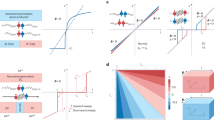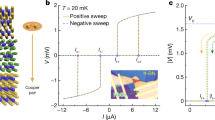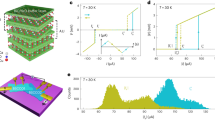Abstract
Nonlinear optical and electrical effects associated with a lack of spatial inversion symmetry allow direction-selective propagation and transport of quantum particles, such as photons1 and electrons2,3,4,5,6,7,8,9. The most common example of such nonreciprocal phenomena is a semiconductor diode with a p–n junction, with a low resistance in one direction and a high resistance in the other. Although the diode effect forms the basis of numerous electronic components, such as rectifiers, alternating–direct-current converters and photodetectors, it introduces an inevitable energy loss due to the finite resistance. Therefore, a worthwhile goal is to realize a superconducting diode that has zero resistance in only one direction. Here we demonstrate a magnetically controllable superconducting diode in an artificial superlattice [Nb/V/Ta]n without a centre of inversion. The nonreciprocal resistance versus current curve at the superconducting-to-normal transition was clearly observed by a direct-current measurement, and the difference of the critical current is considered to be related to the magnetochiral anisotropy caused by breaking of the spatial-inversion and time-reversal symmetries10,11,12,13. Owing to the nonreciprocal critical current, the [Nb/V/Ta]n superlattice exhibits zero resistance in only one direction. This superconducting diode effect enables phase-coherent and direction-selective charge transport, paving the way for the construction of non-dissipative electronic circuits.
This is a preview of subscription content, access via your institution
Access options
Access Nature and 54 other Nature Portfolio journals
Get Nature+, our best-value online-access subscription
$29.99 / 30 days
cancel any time
Subscribe to this journal
Receive 51 print issues and online access
$199.00 per year
only $3.90 per issue
Buy this article
- Purchase on Springer Link
- Instant access to full article PDF
Prices may be subject to local taxes which are calculated during checkout




Similar content being viewed by others
Data availability
The data that support the findings of this study are available from the corresponding author upon request.
References
Rikken, G. L. J. A. & Raupach, E. Observation of magneto-chiral dichroism. Nature 390, 493–494 (1997).
Braun, F. Ueber die Stromleitung durch Schwefelmetalls. Ann. Phys. 153, 556–563 (1874).
Rikken, G. L. J. A. & Wyder, P. Electrical magnetochiral anisotropy. Phys. Rev. Lett. 87, 236602 (2001).
Rikken, G. L. J. A. Magnetoelectric anisotropy in diffusive transport. Phys. Rev. Lett. 94, 016601 (2005).
Pop, F., Auban-senzier, P., Canadell, E., Rikken, G. L. J. A. & Avarvari, N. Electrical magnetochiral anisotropy in a bulk chiral molecular conductor. Nat. Commun. 5, 3757 (2014).
Morimoto, T. & Nagaosa, N. Chiral anomaly and giant magnetochiral anisotropy in noncentrosymmetric Weyl semimetals. Phys. Rev. Lett. 117, 146603 (2016).
Ideue, T. et al. Bulk rectification effect in a polar semiconductor. Nat. Phys. 13, 578–583 (2017).
Tokura, Y. & Nagaosa, N. Nonreciprocal responses from noncentrosymmetric quantum materials. Nat. Commun. 9, 3740 (2018).
Choe, D. et al. Gate-tunable giant nonreciprocal charge transport in noncentrosymmetric oxide interfaces. Nat. Commun. 10, 4510 (2019).
Wakatsuki, R. et al. Nonreciprocal charge transport in noncentrosymmetric superconductors. Sci. Adv. 3, e1602390 (2017).
Qin, F. et al. Superconductivity in a chiral nanotube. Nat. Commun. 8, 14465 (2017).
Yasuda, K. et al. Nonreciprocal charge transport at topological insulator/superconductor interface. Nat. Commun. 10, 2734 (2019).
Hoshino, S., Wakatsuki, R., Hamamoto, K. & Nagaosa, N. Nonreciprocal charge transport in two-dimensional noncentrosymmetric superconductors. Phys. Rev. B 98, 054510 (2018).
Bychkov, Y. A. & Rashba, I. E. Properties of a 2D electron gas with lifted spectral degeneracy. JETP Lett. 39, 78–81 (1984).
LaShell, S., Mcdougall, B. A. & Jensen, E. Spin splitting of an Au (111) surface state band observed with angle resolved photoelectron spectroscopy. Phys. Rev. Lett. 77, 3419–3422 (1996).
Ishizaka, K. et al. Giant Rashba-type spin splitting in bulk BiTeI. Nat. Mater. 10, 521–526 (2011).
Lustikova, J. et al. Vortex rectenna powered by environmental fluctuations. Nat. Commun. 9, 4922 (2018).
Pradipto, A. et al. Enhanced perpendicular magnetocrystalline anisotropy energy in an artificial magnetic material with bulk spin-momentum coupling. Phys. Rev. B 99, 180410 (2019).
Nishimura, T. et al. Fabrication of ferrimagnetic Co/Gd/Pt multilayers with structural inversion symmetry breaking. J. Magn. Soc. Jpn 44, 9–14 (2020).
Ando, F. et al. Fabrication of noncentrosymmetric Nb/V/Ta superlattice and its superconductivity. J. Magn. Soc. Jpn 43, 17–20 (2019).
Wakatsuki, R. & Nagaosa, N. Nonreciprocal current in noncentrosymmetric Rashba superconductors. Phys. Rev. Lett. 121, 026601 (2018).
Yip, S. Noncentrosymmetric superconductors. Annu. Rev. Condens. Matter Phys. 5, 15–33 (2014).
Bauer, E. & Sigrist, M. Non-Centrosymmetric Superconductors: Introduction and Overview (Springer, 2012).
Gor’kov, L. P. & Rashba, E. I. Superconducting 2D system with lifted spin degeneracy: mixed singlet-triplet state. Phys. Rev. Lett. 87, 037004 (2001).
Frigeri, P., Agterberg, D. F., Koga, A. & Sigrist, M. Superconductivity without inversion symmetry: MnSi versus CePt3Si. Phys. Rev. Lett. 92, 097001 (2004).
Fujimoto, S. Electron correlation and pairing states in superconductors without inversion symmetry. J. Phys. Soc. Jpn 76, 051008 (2007).
Yanase, Y. & Sigrist, M. Superconductivity and magnetism in non-centrosymmetric system: application to CePt3Si. J. Phys. Soc. Jpn 77, 124711 (2008).
Smidman, M., Salamon, M. B., Yuan, H. Q. & Agterberg, D. F. Superconductivity and spin-orbit coupling in non-centrosymmetric materials: a review. Rep. Prog. Phys. 80, 036501 (2017).
Edelstein, V. M. Characteristics of the Cooper pairing in two-dimensional noncentrosymmetric electron systems. [Sov. Phys. JETP 68, 1244 (1989)] Zh. Eksp. Teor. Fiz. 95, 2151 (1989).
Itahashi, Y. M. et al. Nonreciprocal transport in gate-induced polar superconductor SrTiO3. Sci. Adv. 6, eaay9120 (2020).
Blaha, P. et al. WIEN2k, An Augmented Plane Wave+Local Orbitals Program for Calculating Crystal Properties (Karlheinz Schwarz, 2018).
Blaha, P. et al. WIEN2k: An APW+lo program for calculating the properties of solids. J. Chem. Phys. 152, 074101 (2020).
Werthamer, N. R., Helfand, E. & Hohenberg, P. C. Temperature and purity dependence of the superconducting critical field, H c2. III. Electron spin and spin-orbit effects. Phys. Rev. 147, 295–302 (1966).
Acknowledgements
We thank Y. Kasahara, Y. Matsuda and K. Ishida for discussions about the superconducting properties of the [Nb/V/Ta]n superlattice. This work was supported partly by JSPS KAKENHI grants (15H05702, 15H05884, 15H05745, 17H04924, 18K19021, 18H04225, 18H01178, 18H05227, 18H01815, 19K21972 and 26103002), by the Cooperative Research Project Program of the Research Institute of Electrical Communication, Tohoku University, and by the Collaborative Research Program of the Institute for Chemical Research, Kyoto University.
Author information
Authors and Affiliations
Contributions
T.O. supervised the study. F.A. and Y.M. deposited the films and fabricated them into the devices. F.A. designed the transport measurement setup with help from T.L. and collected the data. T.A. reproduced the experimental results of the superconducting diode effect in another cryogenic equipment. J.I. and Y.Y. calculated the band structure and helped with the analysis of the experimental results. All authors contributed to the interpretation of the results and to the writing of the manuscript.
Corresponding author
Ethics declarations
Competing interests
The authors declare no competing interests.
Additional information
Publisher’s note Springer Nature remains neutral with regard to jurisdictional claims in published maps and institutional affiliations.
Extended data figures and tables
Extended Data Fig. 1 Band structure of a slab of [Nb/V/Ta]5.
a, Band structure of a slab [Nb/V/Ta]5 along the high-symmetry line. b, Low-energy electron band near the M point.
Extended Data Fig. 2 The nonreciprocal component of the critical current ΔIc as a function of magnetic field in a 120-nm-thick Nb film.
The inset shows the temperature dependence of the d.c. sheet resistance.
Extended Data Fig. 3 First-harmonic sheet resistances Rω of the [Nb/V/Ta]n superlattice as a function of magnetic field in the vicinity of Tc.
The temperature dependence of the critical field Bc2 is shown in the inset.
Rights and permissions
About this article
Cite this article
Ando, F., Miyasaka, Y., Li, T. et al. Observation of superconducting diode effect. Nature 584, 373–376 (2020). https://doi.org/10.1038/s41586-020-2590-4
Received:
Accepted:
Published:
Issue Date:
DOI: https://doi.org/10.1038/s41586-020-2590-4
This article is cited by
-
Intrinsic supercurrent non-reciprocity coupled to the crystal structure of a van der Waals Josephson barrier
Nature Communications (2024)
-
High-temperature Josephson diode
Nature Materials (2024)
-
Superconducting diode effect sign change in epitaxial Al-InAs Josephson junctions
Communications Physics (2024)
-
Parity-conserving Cooper-pair transport and ideal superconducting diode in planar germanium
Nature Communications (2024)
-
Superconducting tunnel junctions with layered superconductors
Quantum Frontiers (2024)
Comments
By submitting a comment you agree to abide by our Terms and Community Guidelines. If you find something abusive or that does not comply with our terms or guidelines please flag it as inappropriate.



